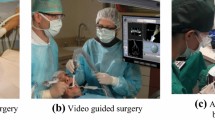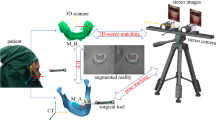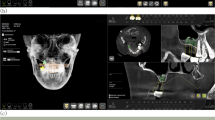Abstract
It is challenging to achieve high implant accuracy in dental implant placement, because high risk tissues need to be avoided. In this study, we present an augmented reality (AR) surgical navigation with an accurate cone beam computed tomography (CBCT)-patient registration method to provide clinically desired dental implant accuracy. A registration device is used for registration between preoperative data and patient outside the patient’s mouth. After registration, the registration device is worn on the patient’s teeth for tracking the patient. Naked-eye 3D images of the planning path and the mandibular nerve are superimposed onto the patient in situ to form an AR scene. Simultaneously, a 3D image of the drill is overlaid accurately on the real one to guide the implant procedure. Finally, implant accuracy is evaluated postoperatively. A model experiment was performed by an experienced dentist. Totally, ten parallel pins were inserted into five 3D-printed mandible models guided by our AR navigation method and through the dentist’s experience, respectively. AR-guided dental implant placement showed better results than the dentist’s experience (mean target error = 1.25 mm vs. 1.63 mm; mean angle error = 4.03° vs. 6.10°). Experimental results indicate that the proposed method is expected to be applied in the clinic.

ᅟ












Similar content being viewed by others
References
Hassfeld S, Mühling J (2001) Computer assisted oral and maxillofacial surgery—a review and an assessment of technology. Int J Oral Maxillofac Surg 30(1):2–13. https://doi.org/10.1054/ijom.2000.0024
Duyck J, Rønold HJ, Van OH, Naert I, Vander SJ, Ellingsen JE (2001) The influence of static and dynamic loading on marginal bone reactions around osseointegrated implants: an animal experimental study. Clin Oral Implants Res 12(3):207–218. https://doi.org/10.1034/j.1600-0501.2001.012003207.x
Eggers G, Patellis E, Mühling J (2009) Accuracy of template-based dental implant placement. Int J Oral Maxillofac Implants 24(3):447–454 http://www.quintpub.com/journals/omi/abstract.php?article_id=4509#.WoFLR_knZ5Y
Pettersson A, Kero T, Gillot L, Cannas B, Fäldt J, Söderberg R, Näsström K (2010) Accuracy of CAD/CAM-guided surgical template implant surgery on human cadavers: part I. J Prosthet Dent 103(6):334–342. https://doi.org/10.1016/S0022-3913(10)60072-8
Casap N, Nadel S, Tarazi E, Weiss EI (2011) Evaluation of a navigation system for dental implantation as a tool to train novice dental practitioners. J Oral Maxillofac Surg 69(10):2548–2556. https://doi.org/10.1016/j.joms.2011.04.026
Block MS, Emery RW (2016) Static or dynamic navigation for implant placement—choosing the method of guidance. J Oral Maxillofac Surg 74(2):269–277. https://doi.org/10.1016/j.joms.2015.09.022
Hoffmann J, Westendorff C, Gomezroman G, Reinert S (2005) Accuracy of navigation-guided socket drilling before implant installation compared to the conventional free-hand method in a synthetic edentulous lower jaw model. Clin Oral Implants Res 16(5):609–614. https://doi.org/10.1111/j.1600-0501.2005.01153.x
Jabero M, Sarment DP (2006) Advanced surgical guidance technology: a review. Implant Dent 15(2):135–142. https://doi.org/10.1097/01.id.0000217790.68814.1e
Kang SH, Lee JW, Lim SH, Kim YH, Kim MK (2014) Verification of the usability of a navigation method in dental implant surgery: in vitro, comparison with the stereolithographic surgical guide template method. J Craniomaxillofac Surg 42(7):1530–1535. https://doi.org/10.1016/j.jcms.2014.04.025
Liao H, Inomata T, Sakuma I, Dohi T (2010) 3-D augmented reality for MRI-guided surgery using integral videography autostereoscopic image overlay. IEEE Trans Biomed Eng 57(6):1476–1486. https://doi.org/10.1109/TBME.2010.2040278
Tran HH, Suenaga H, Kuwana K et al (2011) Augmented reality system for oral surgery using 3D auto stereoscopic visualization. Med Image Comput Comput Assist Interv 14(1):81–88 https://link.springer.com/chapter/10.1007%2F978-3-642-23623-5_11
Suenaga H, Tran HH, Liao H, Masamune K, Dohi T, Hoshi K, Takato T (2015) Vision-based markerless registration using stereo vision and an augmented reality surgical navigation system: a pilot study. BMC Med Imaging 15(1):51. https://doi.org/10.1186/s12880-015-0089-5
Wang J, Suenaga H, Hoshi K, Yang L, Kobayashi E, Sakuma I et al (2014) Augmented reality navigation with automatic marker-free image registration using 3-D image overlay for dental surgery. IEEE Trans Biomed Eng 61(4):1295–1304. https://doi.org/10.1109/TBME.2014.2301191
Kramer FJ, Baethge C, Swennen G, Rosahl S (2005) Navigated vs. conventional implant insertion for maxillary single tooth replacement. Clin Oral Implants Res 16(1):60. https://doi.org/10.1111/j.1600-0501.2004.01058.x
Somogyi-Ganss E, Holmes HI, Jokstad A (2015) Accuracy of a novel prototype dynamic computer-assisted surgery system. Clin Oral Implants Res 26(8):882–890. https://doi.org/10.1111/clr.12414
Arun KS, Huang TS, Blostein SD (1987) Least-squares fitting of two 3-D point sets. IEEE Trans Pattern Anal Mach Intell 9(5):698–700. https://doi.org/10.1109/TPAMI.1987.4767965
Fan Z, Chen G, Wang J, Liao H (2017) Spatial position measurement system for surgical navigation using 3-D image marker-based tracking tools with compact volume. IEEE Trans Biomed Eng 65:378–389. https://doi.org/10.1109/TBME.2017.2771356
Ma L, Zhao Z, Chen F, Zhang B, Fu L, Liao H (2017) Augmented reality surgical navigation with ultrasound-assisted registration for pedicle screw placement: a pilot study. Int J Comput Assist Radiol Surg 12(12):2205–2215. https://doi.org/10.1007/s11548-017-1652-z
Wagner A, Wanschitz F, Birkfellner W, Zauza K, Klug C, Schicho K, Kainberger F, Czerny C, Bergmann H, Ewers R (2003) Computer-aided placement of endosseous oral implants in patients after ablative tumour surgery: assessment of accuracy. Clin Oral Implants Res 14(3):340–348. https://doi.org/10.1034/j.1600-0501.2003.110812.x
Wanschitz F, Watzinger F, Schopper C, Ewers R, Birkfellner W, Figl M, Bergmann H, Patruta S, Kainberger F, Kettenbach J (2002) Evaluation of accuracy of computer-aided intraoperative positioning of endosseous oral implants in the edentulous mandible. Clin Oral Implants Res 13(1):59–64. https://doi.org/10.1034/j.1600-0501.2002.130107.x
Ewers R, Schicho K, Truppe M, Seemann R, Reichwein A, Figl M, Wagner A (2004) Computer-aided navigation in dental implantology: 7 years of clinical experience. J Oral Maxillofac Surg 62(3):329–334. https://doi.org/10.1016/j.joms.2003.08.017
Ewers R, Schicho K, Undt G, Wanschitz F, Truppe M, Seemann R, Wagner A (2005) Basic research and 12 years of clinical experience in computer-assisted navigation technology: a review. Int J Oral Maxillofac Surg 34(1):1–8. https://doi.org/10.1016/j.ijom.2004.03.018
Karamian E, Motamedi MRK, Khandan A et al (2014) An in vitro evaluation of novel NHA/zircon plasma coating on 316L stainless steel dental implant. Prog Nat Sci: Mater Int 24(2):150–156. https://doi.org/10.1016/j.pnsc.2014.04.001
Kazemi A, Abdellahi M, Khajehsharafabadi A et al (2017) Study of in vitro bioactivity and mechanical properties of diopside nano-bioceramic synthesized by a facile method using eggshell as raw material. Mater Sci Eng C Mater Biol Appl 71:604–610. https://doi.org/10.1016/j.msec.2016.10.044
Khandan A, Karamian E, Bonakdarchian M (2014) Mechanochemical synthesis evaluation of nanocrystalline bone-derived bioceramic powder using for bone tissue engineering. Med Hypotheses 5(4):155. https://doi.org/10.4103/2155-8213.140606
Sun Y, Luebbers HT, Agbaje JO, Schepers S, Politis C, van Slycke S, Vrielinck L (2015) Accuracy of dental implant placement using CBCT-derived mucosa-supported stereolithographic template. Clin Implant Dent Relat Res 17(5):862–870. https://doi.org/10.1111/cid.12189
Wang M, Song Z (2009) Improving target registration accuracy in image-guided neurosurgery by optimizing the distribution of fiducial points. Int J Med Rob Comput Assisted Surg 5(1):26–31. https://doi.org/10.1002/rcs.227
Moghari MH, Abolmaesumi P (2009) Distribution of fiducial registration error in rigid-body point-based registration. IEEE Trans Med Imaging 28(11):1791–1801. https://doi.org/10.1109/TMI.2009.2024208
Acknowledgments
We thank Dr. Jiuyue Yu and Shengde Niu of Beijing Enjoy Dental Clinic for their help in the operative component of the experiments and computed tomography data collections.
This work was supported in part by the National Natural Science Foundation of China (81427803, 81771940), National Key Research and Development Program of China (2017YFC0108000), Beijing Municipal Science & Technology Commission (Z151100003915079), Beijing Municipal Natural Science Foundation (7172122), Soochow-Tsinghua Innovation Project (2016SZ0206), and China Postdoctoral Science Foundation (043220007).
Author information
Authors and Affiliations
Corresponding author
Ethics declarations
Conflict of interest
The authors declare that they have no conflict of interest.
Informed consent
This article does not contain patient data.
Rights and permissions
About this article
Cite this article
Ma, L., Jiang, W., Zhang, B. et al. Augmented reality surgical navigation with accurate CBCT-patient registration for dental implant placement. Med Biol Eng Comput 57, 47–57 (2019). https://doi.org/10.1007/s11517-018-1861-9
Received:
Accepted:
Published:
Issue Date:
DOI: https://doi.org/10.1007/s11517-018-1861-9




